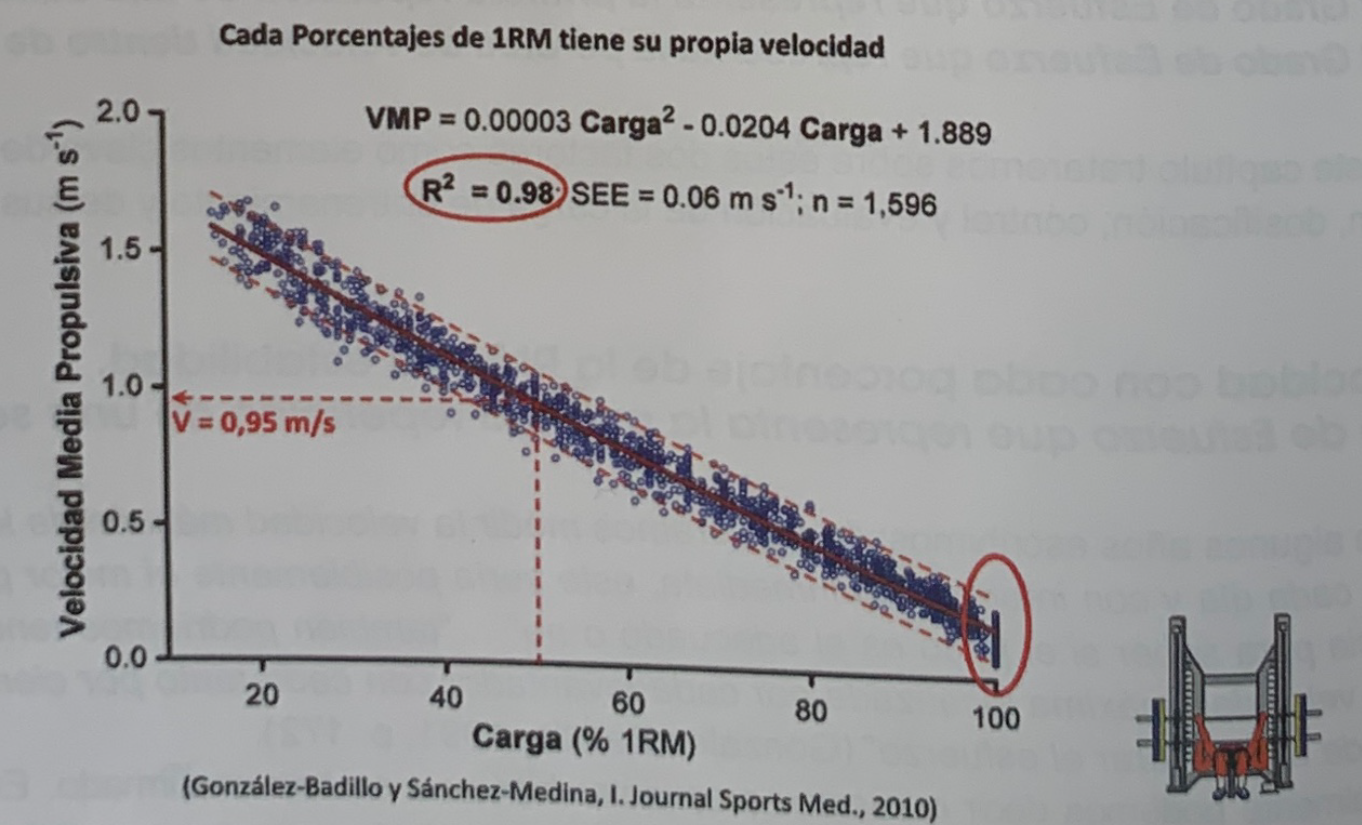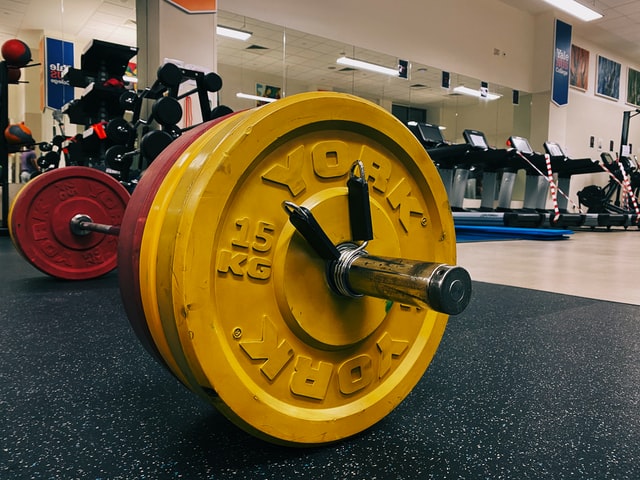Relative Intensity Through Running Speed
To date, it has never been known, even approximately, what the relative intensity has been through the speed of execution and, therefore, what has been the intensity that has produced a certain effect.
In this series of articles we deal with some of the most important concepts of strength training, collecting notes from the recently published book Strength, Speed and Physical and Sports Performance written by renowned researchers Juan José González Badillo and Juan Ribas Serna.
SUMMARY
- Knowing the execution speed of each subject allows us to know the real relative intensity (degree of effort) with which he trains as soon as he performs the first repetition of the series at the maximum possible speed.
- Knowing the execution speed of each subject also makes it possible to know the degree and time of adaptation, and to follow the evolution of performance individually.
If, for example, in a training cycle intensities between 60 and 80% of the RM have been programmed and the training has given good results, the immediate and most common conclusion is that these intensities (with a determined number of repetitions , about which we do not discuss at this time) are very suitable for the improvement of physical performance or for the improvement of strength (the conclusion would have been the same whatever the intensities would have been if the effect was good).
The problem is that, if performance has improved, the actual intensities used are very different from those programmed. This leads to permanent disorientation and prevents improving the training methodology.
Inputs from a single measure of speed at the beginning and end of the training cycle
It is true that measuring the speed in all the series and repetitions of a training program every day can be difficult, especially if it is a large group of participants. But the objective of knowing in a very approximate way the minimum and maximum intensity used in a training cycle can be achieved by measuring the speed with the appropriate loads before and after the training period.
Suppose that a training session of 3 sessions has been programmed with each of the following loads: 60, 65, 70, 75 and 80% of the initial estimated RM. Before beginning the training, the movement speed of a series of progressive loads is measured until reaching an intensity of approximately 80% of the RM of each subject. This 80% intensity is determined taking as a reference the speed with which the loads move, since each percentage has its own speed (González-Badillo and Sánchez-Medina 2010).
From here, the absolute loads (weights) with which they have to train throughout the cycle are calculated for each subject. These loads are calculated based on the indicated training percentages that you train throughout the entire cycle. These loads are calculated based on the training percentages listed above and the estimated individual RM. Each subject trains with the corresponding weights, and once all the training sessions are finished, the speed with which the same average absolute loads are moved in the initial test is measured again.
Let’s imagine that one of the participants has improved his estimated RM by 20% in the exercise with which he has been training, which is deduced from the improvement in speed that he has experienced with the loads in general, and especially with the maximum load that was measured in the initial test.
Faced with this situation, the question would be: what training intensities have produced an improvement of 20% in the exercise trained? The usual response would have been that the intensities were as programmed, from 60 to 80% of the MR.
But as it is easy to understand, this answer is not correct, because if the subject improved his RM by 20%, it means that at least the last training session was performed with approximately 20% less relative intensity than the programmed one, because it is reasonable to accept that the performance improvement demonstrated in the final test had already been achieved in the last session, 48 or 72 hours before said final test.
Therefore, the last real training intensity must have been approximately 20% lower than the programmed one, that is, 60% of the RM that he demonstrated to have 48-72 hours later in the final test. Therefore, it is very probable that the first intensities with 60% have been the only ones that the subject performed at the programmed intensity, since the rest of the training sessions have necessarily been performed at a lower intensity, since the improvement in performance is produces in a way progressive throughout the cycle and especially in the first two thirds of its duration.
knowledge of the true intensity that has produced a certain effect is of great importance for the assessment of the training effect and the degree of effort made
Therefore, as indicated, the training intensities were always very approximately the same, 60% of the RM. All of this allows us to suggest that the correct answer to the question formulated above is that the intensity that produced the 20% improvement in MR was the same relative intensity that was practically stable throughout the entire training period, 60% of the actual RM of the subject. in each session.
That is to say, the only progression of charges has occurred in absolute terms, not in relative terms. We understand that knowledge of the true intensities that have produced a certain effect is of great importance for the assessment of the training effect and the degree of effort made, and therefore, for the improvement of the training methodology.
Of course, none of this would have been possible without measuring the speeds at which the various absolute loads moved before and after the training. This example that has just been described occurs in practice, and is even published several times. For example, in a study carried out with soccer players with a mean age of 15 years, a six-week training session was applied to the squat exercise, with programmed intensities between 45% and 57-60% of RM. estimated before starting the training cycle (Franco-Márquez et al., 2015).
At the beginning and at the end of the training cycle, mean propulsive velocity (VMP) was measured at the same absolute loads, reaching in the initial test a maximum load that the subjects could move at an approximate VMP of 1m*s-1.
These loads are enough to dose the training load and later assess its effect. Once the load of 1 m*s-1 of each subject was known, the absolute loads with which they had to train in each session of the entire training period were programmed.
Athletes improved performance by an average of 29% of the estimated 1RM in the squat
Athletes improved performance by an average of 29% of the estimated 1RM in the squat. Given this improvement, when making the corresponding calculations, it turned out that the average intensity with which the subjects trained in the last session was 45% 1RM. This statement, as we have indicated in the previous example, is easy to explain: if the result is improved by 29% in a final test, it is reasonable to think that 3-4 days before performing this test the same result could have been achieved or a very similar one, maybe even something superior in some case.
Therefore, the relative intensity represented by the absolute load used in the last session would represent a lower percentage of the RM than had been programmed and inversely proportional to the improvement in performance that the subject had already achieved at the time of the last session. .
This means that if the players started training with a relative intensity of 45% of the estimated RM (something quite probable in all the players, since the first session took place 3-4 days after the initial test) and finished training in the last session at the same relative intensity, it is reasonable to accept that the intensity that produced that average improvement of 29% was a practically stable intensity of 45% 1RM.
Therefore, the simple fact of having measured the speed of execution under the same absolute loads only before and after training has allowed, among other applications, the following:
- Avoid performing a 1RM test before and after training.
- Assess the strength of the players with minimal effort.
- Check what real relative intensities had caused the training effect: something completely unknown until now in the history of training.
- Verify that, in many cases, it may be enough to maintain an adequate progression of the absolute load, even though the relative intensity is stable, and even tends to decrease.
- Show that it does not make sense to talk about “periodized training or not” (assuming that the term should be used at some point, which we do not believe is necessary), since the “ideal” is that the training “does not have to be periodized”, since maintaining the same relative intensity (“non-periodized training”) while the absolute training load increases This is clear proof that the effect of training is very positive. In addition, a wide range of Upper relative intensities is kept available and useful which may need to be applied at later stages.
Check what real relative intensities had caused the training effect: something completely unknown until now in the history of training.
But the applications that can be derived from two simple measurements of speed with light loads do not end here, but rather everything that we have described in the previous paragraphs has been able to be assessed individually in each of the players. Figure 1 presents the data on the maximum relative intensity with which each player trained in the last session.
The points that appear in figure 1 represent the maximum relative intensity with which each of the 20 players who participated in the study trained. The numbers indicated on the “X” axis only serve to name each player, so the order is random, and has no evaluative meaning. The red horizontal line at value 45 of the “Y” axis means the programmed minimum relative intensity, and the line at value 57 is the programmed maximum relative intensity. 
Figure 1. Maximum intensity with which each player trained in the last session of the training period, estimated based on the change in performance obtained by each player (Franco-Márquez, et al., 2015).
It can be seen that 10 of the players ended up training with a relative intensity lower than the minimum programmed. This means that these 10 players trained in regression in terms of relative intensity. That is, despite the fact that the absolute load tended to rise throughout the training cycle, these subjects tended to train with less and less relative intensity (less effort).
Of all of them, the one who trained the least, that is, the one who made the least effort, was number 10, whose relative load in the last session was slightly above 35% of the RM. But from this it cannot be deduced that “the less you train, the more you improve”, because this subject has not improved more because he has trained less, but he has trained less because he has improved more. In other words, the cause-effect relationship is: if I improve more, I train less, and not if I train less, I improve more.
the cause-effect relationship is: if I improve more, I train less, and not if I train less, I improve more.
The sequence “if I improve more, I train less” should be considered as “a law” within the sports training methodology. The “I improve more…”, as a comparative expression that it is, can be applied in two ways. The first refers to improving more than what is represented in relative terms by the progression of the programmed absolute load to be moved: in this case, the speed at which the absolute load is moved is higher than that which would correspond to the programmed percentage that represents said absolute charge.
In these cases, the apparently most logical decision would be to increase the predicted absolute load so that it represents the percentage with which it was programmed to train, but, probably, the most effective and rational thing would be to maintain the predicted increase in absolute load, although programmed relative intensity will drop, that is, even if the subject trains less.
The second refers to the fact that a subject improves much more than the rest of those that make up the training group. In these cases -and this is not even apparent logic- the mistake of “training the one who improves the most” is frequently made, because if “he has more possibilities”, “if he is better”, “you have to train him more to obtain the maximum result..”
Considering that the decision in this case should be the opposite, the subject that improves more rapidly should train less, with less relative intensity, than the others: the greater the subject’s response to the same stimulus (it can be absolute or relative), the less stimulus should be applied to the subject. Although you should always try to maintain the progression of the absolute load.
the subject that improves more rapidly should train less, with less relative intensity, than the others: the greater the subject’s response to the same stimulus (it can be absolute or relative), the less stimulus should be applied to the subject.
Another 9 players that made up the group trained with more or less progression, but without reaching the maximum programmed relative progression, and only one trained with the maximum programmed relative intensity, player number 18, who naturally did not improve his performance at all. : if, in the face of a progressive increase in a series of absolute loads, you really train with the relative loads that these absolute loads represent, that is, if, under these conditions, you train with the programmed relative loads, it means that performance is not improved at all .
Conclusions derived from the use of speed to estimate the relative intensity
Therefore, in addition to what was previously indicated when talking about the derived applications when analyzing the results as a group, the measurement of speed only before and after training allows adding a series of new applications when the results are analyzed individually, such as following:
- Knowing what the minimum and maximum intensity at which each player actually trained was and, therefore, not only knowing what the average effect on the group was, but also the individual effect of the training and the load that caused it in each subject.
- Know specific data on the possible magnitude of the differences that can occur between subjects, with the same characteristics, who, theoretically, had to do the same training, reaching differences in relative intensity of up to 20%.
- Knowing the characteristics of the subjects as responders to training: differences in adaptation or response to training stimuli.
- Be aware of the need to consider the importance of training individualization: by nature, it is not possible to train a group of subjects with “the same training”.
- Understand that you can’t say that a given workout is the “best” either. So we could say that “there is no training, but subjects who train or trainable subjects”, because each subject can respond to the training load differently.
- Discover new approaches to reflect on the relationship between the burden and its effect in general terms and on each person individually.
Naturally, none of this had been possible up to now in the field of sports training. Only by properly controlling the speed of execution is it possible to incorporate all this information, which is decisive for improving the training methodology.
Contributions of the speed measurement at the beginning and at the end | of the training cycle and during all sessions
If the speed of the first repetition of each series can be measured in all the training sessions, we will have all the contributions that we have already commented on in the previous section, but with much more abundant, precise and efficient information. individualized of the effect of the training and the relative load with which each person has trained, which allows new contributions.
Although the previous procedure has given a lot of information, as it has been possible to verify, it has the deficiency that it is not known in detail what has happened during the training phase, between the first and the last measurement, and this can be important. Indeed, if the training is programmed in the same way as in the case described above, the measurement of the speed of the first repetition in each series allows us to know the real relative intensity with which each subject trains each day and therefore the change that is taking place in its performance, which is evaluated and valued by the speed changes under the same absolute loads.
This information can be translated into a estimate of the effect that training is having on the RM of the exercise with which you train, although, naturally, without the need to measure it directly. Therefore, far exceeding what we have already been able to know with the previous procedure, now it is possible to know what has been the evolution of intensity and performance during each session throughout the cycle.
Undoubtedly, this is the dream, or should be, of every person who is dedicated, not only to training usually called “strength training”, but to any other, especially when the objective is to improve physical performance. This information allows for a wide range of analyses.
For example, if two subjects have finished the training cycle with the same improvement in performance, it is logical to think that the training effect for both has been the same or very similar, and, moreover, on the same date. However, having been measuring their execution speed at each absolute load throughout the cycle, we have been able to know the evolution of the intensity and performance of each one of the subjects, which allows us to verify if, indeed, the training load and the The effect of training has evolved in parallel or not throughout the cycle.
This is important because it could be the case that one of the subjects had peaked one, two or three weeks before reaching the end of the cycle, his performance having subsequently declined, which is very different from having had, for example , a constant positive evolution throughout the cycle.
the times and degree of adaptation of the two subjects are different
This would be indicating two very relevant facts: the times and degree of adaptation of the two subjects are different. For this reason, the observation of the same performance for both at the end of the cycle is pure coincidence, since the effect of the training has been different in the degree of adaptation and in the moment in which it has been produced. This is a key issue when training an athlete, since one of the most important individual differences is precisely the adaptation time, understood in this case as the number of sessions for a certain load (synthesis of intensity-volume) necessary for a certain degree of positive adaptation to occur in a training cycle.
conclusions
From the above, the following can be concluded:
- The measurement of the speeds at which the absolute loads move before and after the completion of the training and during each session allows:
- Assess the effect of individual training in each session: evolution of performance individually.
- To know the real relative intensity (degree of effort) with which each subject trains as soon as he performs the first repetition of the series at the maximum possible speed.
- Know the degree and time of adaptation individually.
- Discover the degree of disparity in the adaptation responses between subjects that we normally consider to have the same characteristics when they perform the “same” training.
- Justify the need to consider the importance of training individualization: by nature, it is not possible to train all the components of a group of subjects / athletes with “the same training”.
- Quantify the degree of differentiation between subjects in relation to the intensity with which they train and the effect that said intensity produces on them.
- Discover new approaches to reflect on the relationship between the burden and its effect in general terms and on each person individually.
- Improve the training methodology, based on the contributions indicated in the previous points.















